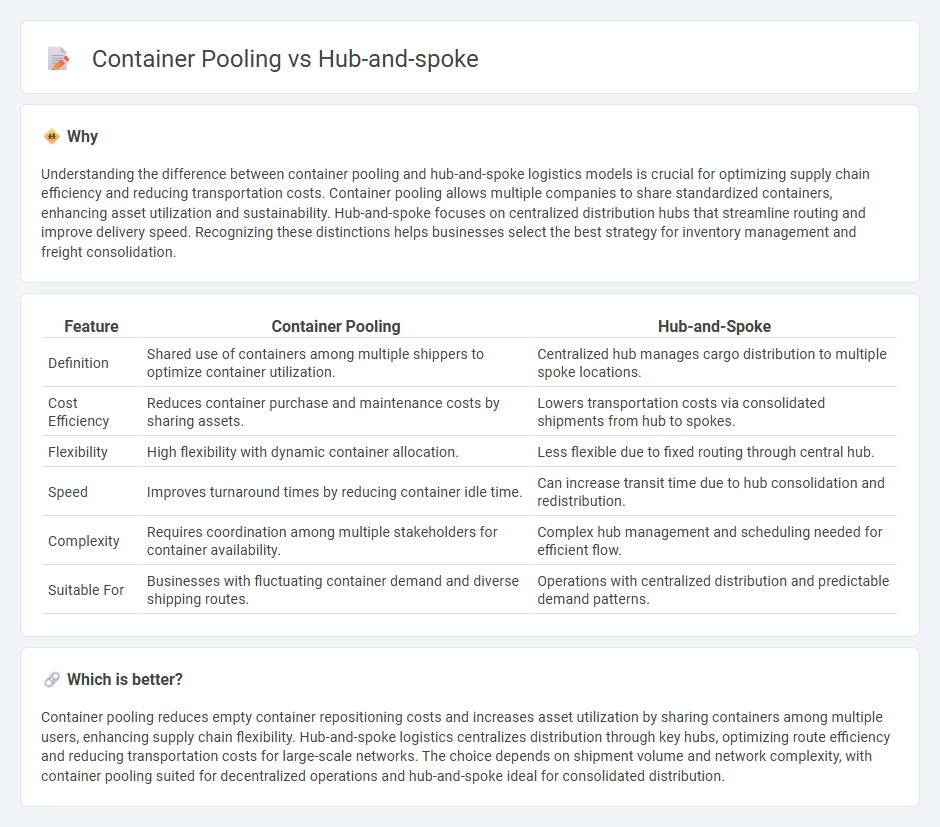
Container pooling enhances asset utilization by sharing containers among multiple shippers, reducing empty trips and lowering costs in logistics operations. Hub-and-spoke systems concentrate freight at central hubs before redistribution, optimizing route efficiency and delivery times across networks. Explore these logistics models to discover which strategy best suits your supply chain needs.
Why it is important
Understanding the difference between container pooling and hub-and-spoke logistics models is crucial for optimizing supply chain efficiency and reducing transportation costs. Container pooling allows multiple companies to share standardized containers, enhancing asset utilization and sustainability. Hub-and-spoke focuses on centralized distribution hubs that streamline routing and improve delivery speed. Recognizing these distinctions helps businesses select the best strategy for inventory management and freight consolidation.
Comparison Table
| Feature | Container Pooling | Hub-and-Spoke |
|---|---|---|
| Definition | Shared use of containers among multiple shippers to optimize container utilization. | Centralized hub manages cargo distribution to multiple spoke locations. |
| Cost Efficiency | Reduces container purchase and maintenance costs by sharing assets. | Lowers transportation costs via consolidated shipments from hub to spokes. |
| Flexibility | High flexibility with dynamic container allocation. | Less flexible due to fixed routing through central hub. |
| Speed | Improves turnaround times by reducing container idle time. | Can increase transit time due to hub consolidation and redistribution. |
| Complexity | Requires coordination among multiple stakeholders for container availability. | Complex hub management and scheduling needed for efficient flow. |
| Suitable For | Businesses with fluctuating container demand and diverse shipping routes. | Operations with centralized distribution and predictable demand patterns. |
Which is better?
Container pooling reduces empty container repositioning costs and increases asset utilization by sharing containers among multiple users, enhancing supply chain flexibility. Hub-and-spoke logistics centralizes distribution through key hubs, optimizing route efficiency and reducing transportation costs for large-scale networks. The choice depends on shipment volume and network complexity, with container pooling suited for decentralized operations and hub-and-spoke ideal for consolidated distribution.
Connection
Container pooling enhances hub-and-spoke logistics by centralizing container resources at key hubs, facilitating efficient redistribution to spokes and reducing empty container movements. This system optimizes asset utilization and cuts transportation costs in supply chains through shared container networks. Effective container pooling supports hub-and-spoke models by enabling scalable, flexible shipment consolidation and improving overall network sustainability.
Key Terms
Centralization (Hub-and-Spoke)
Hub-and-spoke centralization consolidates inventory and resources at a single hub, improving control and reducing redundancy across the supply chain. This model enhances operational efficiency by streamlining processes, enabling economies of scale, and facilitating faster decision-making compared to decentralized approaches. Explore how hub-and-spoke centralization can optimize your logistics strategy.
Asset Sharing (Container Pooling)
Asset sharing through container pooling maximizes utilization by distributing a common set of containers across multiple shippers, reducing empty container repositioning and lowering operational costs. In contrast, the hub-and-spoke model centralizes container handling at a hub to optimize routes and consolidate shipments, but may face challenges in balancing container availability at spokes. Explore the benefits and implementation strategies of container pooling to enhance supply chain efficiency and asset optimization.
Network Efficiency
Hub-and-spoke architecture optimizes network efficiency by centralizing data flow through a main hub, reducing redundancy and simplifying route management. Container pooling enhances resource utilization by dynamically allocating container instances across various nodes, minimizing idle capacity and improving load balancing. Explore detailed comparisons to understand which strategy best fits your network requirements.
Source and External Links
What is a Hub-and-Spoke Network: 9 Tips, Benefits & Limitations - The hub-and-spoke network is a centralized system where a central hub coordinates multiple spokes (partner organizations or nodes), streamlining communication, decision-making, and resource allocation while each spoke interacts primarily with the hub and not with each other.
Spoke-hub distribution paradigm - Wikipedia - The hub-and-spoke system, originally pioneered in commercial aviation by Delta Air Lines, is a transport topology model where outlying points (spokes) connect to a central hub, optimizing routes compared to point-to-point models and widely adopted in logistics and telecommunications.
Hub-spoke network topology in Azure - Azure Architecture Center - In cloud networking, a hub-spoke topology connects multiple spoke virtual networks to a central hub virtual network that hosts shared services, provides cross-premises connectivity, traffic routing, and controlled access, enabling secure and scalable network architecture.
 dowidth.com
dowidth.com